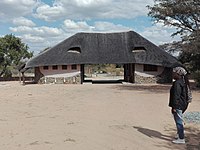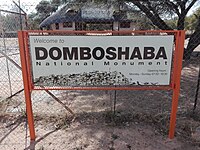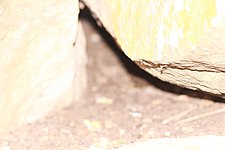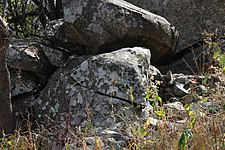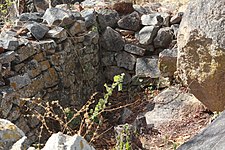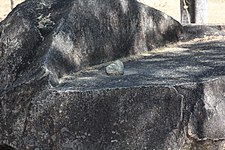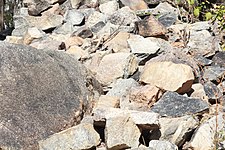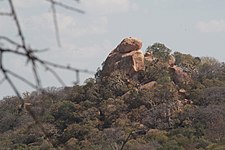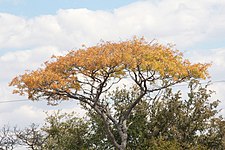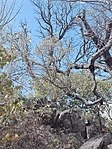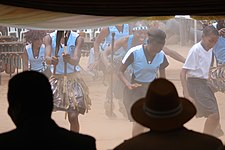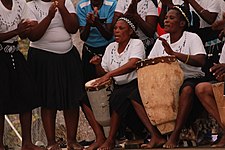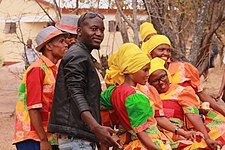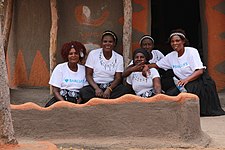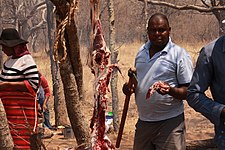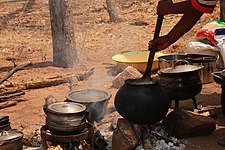Domboshaba
This article needs additional citations for verification. (June 2017) |
Domboshaba | |
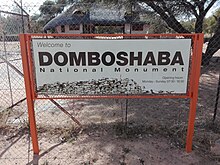 Domboshaba heritage site | |
 | |
| 20°40′S 27°25′E / 20.667°S 27.417°E | |
| Location | Masunga Village |
|---|---|
| Type | Monument |
| Opening date | (1250–1450 AD) |
| Dedicated to | History of Bakalaka |
Domboshaba [pronunciation?] ruins is a cultural and heritage site in Botswana originally occupied towards the end of the Great Zimbabwe period (1250–1450 AD). The site is a respected place for the people living in the region and it is believed that the chief lived on the top of the hill together with his helpers or assistants.[1][2]
The phrase Dombo means hill and the word Shaba means red (translated from the Ikalanga language means "red" or eland Hill).[3] Domboshaba is also called the Luswingo used to be the settlement of the Great chief of that time. The ruins are similar to the Mwenemotapa. The chief's wife settled below the hill. Domboshaba has other ranges of hills along it, a natural water well located in Mantenge hill, called Mantenge Well which never dries up: the well is 7 metres deep and is situated in the rock.[4][5]
Cultural Heritage
[edit]-
Cultural heritage
Domboshaba is an open site of more than 8 hectares. On the hilltop there are dry stone walls which form private enclosures. Most of these stone walls have an average height of 1.8 metres. The stone wall structures are mostly free standing with a few platforms which mainly form part of the entrances. There are 15 visible dakha floors representing the presence of huts. The site has been revered by local people and has been protected by local taboos until the advent of colonialism, from that point onwards there was a lot of treasure hunting, the site was excavated by treasure hunters and archaeologists.[3]
Rules at the site
[edit]-
Rules at Domboshaba monument
Rules
Domboshaba is a national monument administered by the Botswana National Museum and protected by the revised Monuments and Relics Act (2001).[6]
Grinding stone (Milling stone)
[edit]The milling stone was used to grind food-stuffs such as tobacco and groundnuts.[citation needed]
Gallery of Domboshaba
[edit]- Domboshaba in Pictures
-
Stone at the monument
-
entrance of Domboshaba Monument(Gate house)
-
Domboshaba
-
Trees at Domboshaba
-
Trees at Domboshaba
-
Welcome to Domboshaba (Khami type site)
-
caverns at the site
-
Trees at the site
-
Stone walls
-
Stone walls
-
The grinding stone (used for grinding tobacco)
-
Pathway designed by people who were staying there in the past.
-
Domboshaba hill
Domboshaba gate house
[edit]The Domboshaba gate house was constructed and opened by the Kalakamati Community through the Ipelegeng programme (Self reliance) in collaboration with the department of national museum and monuments.[7]
-
Domboshaba gate house
-
entrance of Domboshaba Monument(Gate house)
The chief's residence
[edit]The dry stone walling is a building method by which structures are constructed from stones without any mortar to bind them together. The hill top was the residence of the chief, his religious advisor and closer attendants. The hilltop has six stone wall enclosures while the lower part has one main enclosure divided into several enclosures where the chief's wives and family lived.[8]
-
Domboshaba stone walls
-
Domboshaba Stones
Grinding Stone
[edit]This is a milling stone which was used at Domboshaba to grind tobacco, ground nuts and sorghum. Reaffirming the notion that the site was a very prominent trading centre occupied by Iron Age farmers. Quern stones work in pairs. The lower stationary stone is called the Quern, while the upper mobile is called a hand-stone. The original former stone has been vandalized by unknown persons.
-
Grinding stone used to pound tobacco and nuts at Domboshaba ruins
Dakha floors
[edit]There are remains of several dakha floors found at the Domboshaba monument made of soil mixed with cow dung spread across the monument. The older dakha house floors were exposed by amateur archaeologists and soil erosion over time. These floors were made with soils that have high ratio of clay to gravel. It is believed that the house floors were fired to strengthen them for longer periods.[2]
Domboshaba cultural festival
[edit]Domboshaba Cultural festival started in 2000 when Mukani Action Campaign (MAC) and the Balumbidzi be iKalanga (The Society for the Promotion of iKalanga Language (SPIL) embarked on a search for ways to promote and celebrate the culture and history of the Kalanga people.[9] Domboshaba monument hosts an annual festival event at the heritage site every year.[10][11] The event comprises distinguished guests from different backgrounds to come and witness the culture and tradition of Kalanga people. This event is respected and sponsored by the Botswana tourism organisation to openly create awareness about the event and the monument site, this will also be the time to share Kalanga tradition experience and have a taste of the different traditional foods ranging from Delele, Nyembah, Topii, Morogo wa dinawa, Zengwe, Lebelebele and others. Domboshaba cultural festival does not only attract the audience from the Botswana and Zimbabwe, rather the events done there exposes the culture of Kalanga people.[12][13]
- cultural festival
-
Dihosana dance troupe at the Domboshaba cultural festival 2017
-
Chimone Kalanga meal
-
Artefacts_displayed_at_Domboshaba_cultural_festival_2017
-
Dihosana_Dance_troupe_7 during the cultural festival in 2017
-
Folk_dance_troupe during the cultural festival 2017
-
Hosanas_in_front_of_a_thatched_traditional_house_at_Domboshaba_cultural_festival
-
Kalanga_man_axing_goat_meat_at_the_Domboshaba_cultural_festival_2017
-
Kalanga_woman_steering_chimonye_meal_(Kalanga)_at_Domboshaba_cultural_festival
Festival schedule
[edit]Domboshaba festival is scheduled to take place every year in September 26–28.
Domboshaba cultural trust
[edit]Domboshaba cultural trust or DTC is one of the sponsors of Domboshaba cultural festival and since its formation in the year 2007 it has become an annual event to bring together youth from Kalanga tradition and other groups to learn about the culture and tradition of Kalanga people.[14]
References
[edit]- ^ "Domboshaba ruins". Republic of Botswana, Government portal. Retrieved 14 June 2017.
- ^ a b Walker, Nick (2010). "Recent Research at Domboshaba Ruin, North East District, Botswana". Botswana Notes and Records. 42: 147–153. ISSN 0525-5090. JSTOR 23237979.
- ^ a b Brook, Michael C. (2017). Botswana Monuments, Heritage sites and Museums. Gaborone, Botswana: Kwena Pools. p. 100. ISBN 9789996805660.
- ^ "Conservation and Development of Mantenge Conservation Area (Botswana) - Sécheresse info". www.secheresse.info. Retrieved 24 May 2022.
- ^ "Exploring Tourism Botswana". Archived from the original on 3 December 2019.
- ^ Deacon, Harriet; Dondolo, Luvuyo; Mrubata, Mbulelo; Prosalendis, Sandra (2004). The Subtle Power of Intangible Heritage: Legal and Financial Instruments for Safeguarding Intangible Heritage. HSRC Press. ISBN 978-0-7969-2074-4.
- ^ Allafrica. "Domboshaba gate house". Allafrica.com. Gladys Olebeng. Retrieved 10 July 2017.
- ^ "Chiefs residence at Domboshaba". FortuneofAfrica. Archived from the original on 29 June 2017. Retrieved 10 July 2017.
- ^ Priti, Jain; Nathan, Mnjama (21 December 2016). Managing Knowledge Resources and Records in Modern Organizations. IGI Global. ISBN 978-1-5225-1966-9.
- ^ "Domboshaba Cultural festival". Botswana Tourism. BTO. Retrieved 17 August 2017.
- ^ "Domboshaba Festival, the heart of the Bakalanga people". Sunday Standard. 10 October 2010. Retrieved 18 March 2021.
- ^ "Domboshaba festival". Botswana daily news online. Archived from the original on 28 June 2021. Retrieved 17 August 2017.
- ^ "Domboshaba Festival of Culture and History". Music In Africa. 9 September 2016. Retrieved 18 March 2021.
- ^ "Domboshaba cultural trust". Daily news online. BDNO. Archived from the original on 18 August 2017. Retrieved 18 August 2017.





